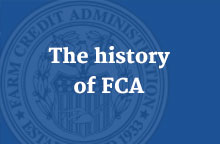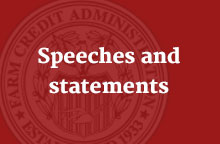About RBCST revisions
FCA’s Office of Secondary Market Oversight designed and maintains the Risk-Based Capital Stress Test for Farmer Mac. We adopt changes to the RBCST periodically. Substantive changes require actions by the FCA board and adjustments to our regulations. Technical changes do not.
About RBCST version 4.2
FCA revised RBCST version 4.1 in July 2018 (renumbering it as version 4.2) to correct an issue with the test’s cashflow generator involving its Institutional Credit line of business (formerly known as AgVantage Plus). This was a technical change.
Since 2001 when the test was introduced, the RBCST has used a “steady-state” approach – that is, as business volume matures over the model’s 10-year time horizon, it is automatically replaced with new volume. In this way, the size of the balance remains constant over the 10 forecasted years.
In 2008, RBCST version 3.0 created an exception to the steady-state approach for AgVantage bonds: as these bonds mature, they are not replaced with new bonds. The exception was made because at the time it was not clear this new product would be a long-term line of business for Farmer Mac — though it has indeed become one.
The issue with the cashflow generator became apparent because of a recent unusually high volume of near-term AgVantage bond maturities. While the generator was indeed halting earnings-related cashflows, it appears to have been incorrectly extending cashflow for funding expenses. Version 4.2 aims to correct the mismatch between earnings cashflow and expenses cashflow.
About RBCST version 4.1
We revised RBCST version 4.0 in April 2018 to reflect changes to the corporate tax code. This, too, was a technical change.
The Tax Cuts and Jobs Act of 2017, which was signed into law in December 2017, changed the corporate tax code by imposing a flat tax rate of 21 percent on all income over $50,000.
We revised the RBCST 4.0 to reflect this change. This involved changing rows 74 through 82 on the Assumptions & Relationships spreadsheet of the RBCST.
In version 4.0, the rows were as follows. (Note: Dollars are in thousands.)
| Income over | but less than | Tax is: | Tax rate | of the amount over |
|---|---|---|---|---|
| $- | $50 | $- | 15% | $- |
| $50 | $75 | $7.50 | 25% | $50 |
| $75 | $100 | $13.75 | 34% | $75 |
| $100 | $335 | $22.75 | 39% | $100 |
| $335 | $10,000 | $113.90 | 34% | $335 |
| $10,000 | $15,000 | $3,400.00 | 35% | $10,000 |
| $15,000 | $18,333 | $5,150.00 | 38% | $15,000 |
| $18,333 | $- | 35% | $- |
In version 4.1, the rows changed to the following:
| Income over | but less than | Tax is: | Tax rate | of the amount over |
|---|---|---|---|---|
| $- | $50 | $- | 15% | $- |
| $50 | $75 | $7.50 | 21% | $50 |
| $75 | $100 | $12.75 | 21% | $75 |
| $100 | $335 | $18.00 | 21% | $100 |
| $335 | $10,000 | $67.35 | 21% | $335 |
| $10,000 | $15,000 | $2,097.00 | 21% | $10,000 |
| $15,000 | $18,333 | $3,147.00 | 21% | $15,000 |
| $18,333 | $- | 21% | $- |
RBCST 4.1 was used for the first time for the first quarter of 2018. For that quarter, the effect of the tax rate change on the RBCST was to increase the capital requirement. We expect this will generally be the case for future quarters because the new lower tax rate reduces the amount of tax benefit derived from tax losses carried forward.
FCA regulations found at § 652.65(a)(3) of title 12 require the RBCST to apply the appropriate corporate income tax schedule.



